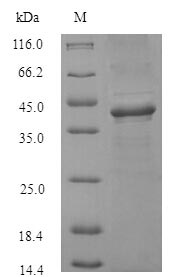Recombinant Staphylococcus aureus Clumping factor A (clfA) is produced in a yeast expression system, covering amino acids 229-559. This partial protein comes with an N-terminal 10xHis-tag for easier purification and detection. The product achieves purity levels over 90%, as confirmed by SDS-PAGE analysis. It's designed strictly for research use and appears to deliver reliable performance in experimental contexts without endotoxin interference.
Clumping factor A plays a crucial role in how Staphylococcus aureus causes disease, particularly in bacterial adhesion and aggregation. The protein binds to fibrinogen—a process that seems essential for colonization and infection of host tissues. Understanding clfA's function may be vital for developing insights into bacterial behavior and potential therapeutic strategies.
Potential Applications
Note: The applications listed below are based on what we know about this protein's biological functions, published research, and experience from experts in the field. However, we haven't fully tested all of these applications ourselves yet. We'd recommend running some preliminary tests first to make sure they work for your specific research goals.
Based on the provided information, the recombinant clfA protein may not be correctly folded or fully bioactive without experimental validation. clfA is a bacterial adhesin that requires proper folding for its fibrinogen-binding function, and the yeast expression system, while eukaryotic, may not fully replicate the native bacterial folding environment. The protein is partial length (229-559aa), which might exclude critical regions needed for complete activity, such as full-domain integrity or post-translational modifications. The N-terminal 10xHis tag is relatively small and may not severely interfere with folding, but it could cause steric hindrance near functional sites. The purity >90% indicates low contaminants, but does not guarantee correct folding. Without validation (e.g., circular dichroism for secondary structure, fibrinogen-binding assays), the folding status and bioactivity remain uncertain. Therefore, while the probability of correct folding is moderate, it is not assured.
1. Antibody Development and Characterization
This recombinant clfA is suitable for antibody generation, but antibody specificity depends on the protein's folding state. If correctly folded, antibodies may recognize native epitopes; if misfolded, they could target non-conformational epitopes, reducing utility for detecting physiological clfA. The His-tag aids purification but may dominate immune responses. For reliable antibodies, validate specificity against native clfA or use tag-free protein.
2. Protein-Protein Interaction Screening
The His-tagged clfA fragment can be used in pull-down assays, but interactions may be tag-mediated or non-specific if the protein is misfolded. The partial length might truncate binding interfaces, leading to false negatives. For biologically relevant results, validate folding first and include controls (e.g., tag-only or misfolded protein) to distinguish specific interactions. Mass spectrometry analysis should be interpreted cautiously without folding confirmation.
3. Structural and Biochemical Characterization
This recombinant clfA is applicable for structural studies only if the His-tag is removed and folding is validated. The tag and partial length may cause heterogeneity, hindering high-resolution structure determination (e.g., in crystallography or NMR). Biophysical analyses (e.g., circular dichroism) can assess folding, but data may be confounded by the tag. For meaningful insights, use tag-free protein and confirm native-like structure.
Final Recommendation & Action Plan
To ensure reliable outcomes, first validate the folding and bioactivity of the recombinant clfA using techniques such as circular dichroism to confirm secondary structure, fibrinogen-binding assays (e.g., ELISA or SPR) to verify function, and size-exclusion chromatography to assess oligomeric state. If possible, remove the His-tag for structural and functional studies to minimize artifacts. For applications like antibody development, proceed with caution and include controls for tag specificity. Always compare results with full-length or native clfA standards to account for partial length limitations.






